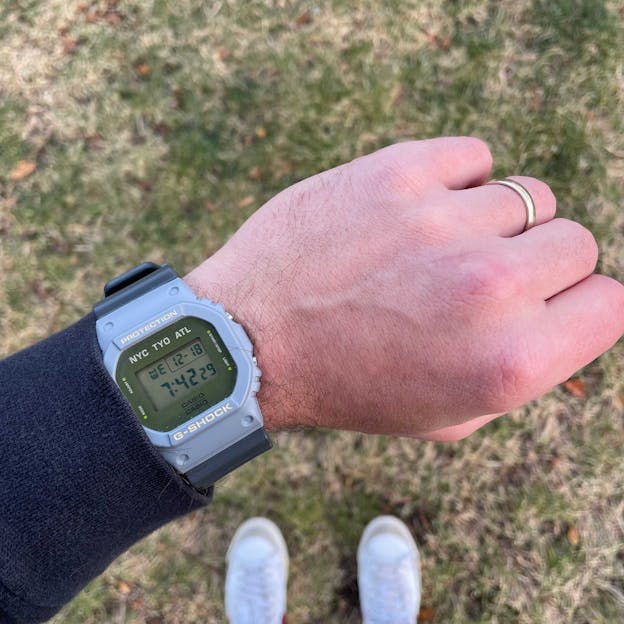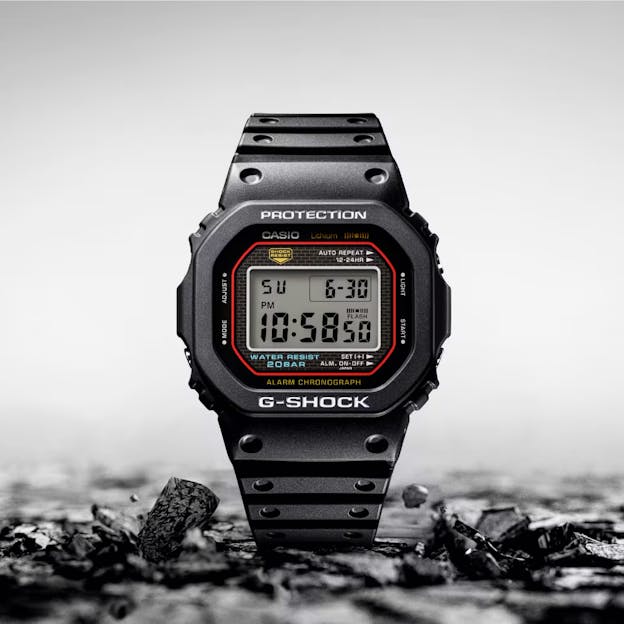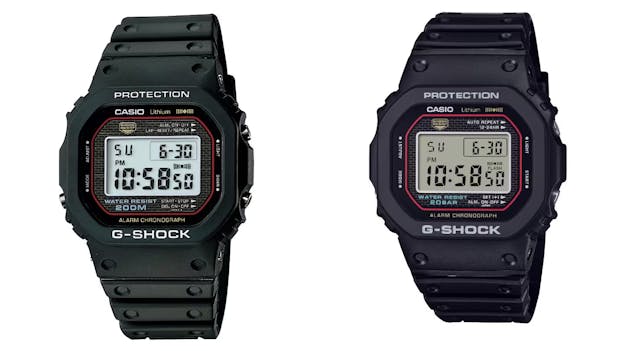Highs and Lows: The Full Spectrum Of G-SHOCK Collecting
From sub-$100 beaters to $3,000 titanium-clad samurai tributes. A look at two very different G-SHOCKs—and how both belong in the conversation about meaningful watch collecting.
I’m not a finance guy. Never have been. Analyzing market trends, debating tariffs, tracking trade deficits, it just doesn’t do it for me. My version of financial planning is figuring out how to pay for daycare and maybe save for a family vacation or two.
That said, I can’t ignore the reality that the world I work in, luxury watches, is deeply tied to the world of finance. Whether we admit it or not, part of what gives this space its mystique is the value, literal, monetary value, we place on the objects we admire, research, and sometimes spend our hard-earned dollars on.
But I don’t believe that anyone should be priced out of this world. Collecting watches, at its best, should be an open invitation, not a velvet rope.
Looking at price ranges, then, can actually be a useful exercise, not as a flex, but as a kind of study. A menu of sorts. The optimistic take is this: most luxury brands do offer what I’d consider entry points. “Affordable,” of course, is relative. But taking stock of the high and low ends of a brand’s catalog gives us a clearer picture of the paths into this hobby and the levels of engagement it can offer.

Take G-SHOCK, for example. It’s a perfect case study. Beloved by high-end collectors and first-time buyers alike, G-SHOCK often serves as a gateway into the watch world, usually after someone moves on from the Nixon they grabbed at the local PacSun. I’ll always have a soft spot for G-SHOCK, quartz movement be damned. They’ve earned their place in the horological landscape. And as the weather warms and my wrists start sweating like a bald Estonian in the World’s Strongest Man competition, it’s one of my favorite watches to wear.
So, for this little exercise, I decided to dig through some of our current offerings, not as a sales pitch, but to show what’s actually out there and accessible to today’s general consumer.
A Little History Of G-SHOCK

Our story starts in 1981 with Casio engineer Kikuo Ibe. As the story goes, which is well-documented across the internet by now, the idea struck him after the mechanical watch his father gave him shattered on the ground. One accidental bump with a rogue pedestrian, and it was toast. From that moment, Ibe set out to create a watch that could survive real life.
His goal was what he dubbed, “Triple 10” resistance. This essentially meant a watch that could withstand 10-bar water pressure (100 meters), run on a battery for 10 years, and survive a 10-meter fall.
In the early ’80s, that kind of durability was unheard of. Today, with our modern materials and tech, it might not sound as wild, but back then, it bordered on science fiction.
So Ibe assembled a small team, nicknamed “Team Tough” (because, of course, we watch folks love our alliteration), and they began prototyping. Nearly 200 attempts later, they still hadn’t cracked the code.
And then came a moment of playground epiphany.
Watching kids bounce rubber balls around, Ibe noticed that the center of the ball doesn’t feel the same shock on impact as the outside. Not exactly Einstein-level revelation, but enough of a breakthrough to inspire the “floating module” concept that would take G-SHOCK from idea to reality.

Two years later, in April 1983, Casio launched the DW-5000C. Its revolutionary “hollow design” housed the internal metal module suspended within a protective plastic case, shock-resistant, water-resistant, and ready to take a beating.
Casio paired it with a clever marketing campaign that showed the watch getting smacked by a hockey stick. It worked. By 1998, over 200 different G-SHOCK models had hit the market, and the legend was well underway.
The Affordable Option: GM2100 Series

The reference number GMAP2100BB-1A—more letters than numbers, really—might not be as iconic as the DW-5000C, but it’s still every bit a G-SHOCK. And at just $99, it’s a fantastic entry point into the world of luxury-adjacent watches.
Its all-black design and octagonal case shape are quintessential G-SHOCK. With 200 meters of water resistance, this thing can handle just about anything. At around 40mm in diameter and only 11.2mm thick, it wears surprisingly well, nothing like the wrist equivalent of a lifted truck.
Its dual analog/digital display includes world time in 31 time zones and five daily alarms, making it an ideal travel companion that won’t flinch at a beating or a saltwater plunge. Oh, and it has a double LED “Super Illuminator” for both the face and digital readout, because of course it does.
It’s also worth noting that it weighs just 40 grams, about 20% lighter than the GA2100-1A1.
Horological credibility? Check. Real-world functionality? Check. Fully watch-snob approved? Also check. Like I said, luxury doesn’t always mean expensive, you just have to know where to look.
Find out more about the G-SHOCK GM2100.
The High Option: MRGB2000R-1A

One day I want a nickname as cool as Mr. G. I mean my former students called me that but beyond the walls of my old Brooklyn classroom it never really caught on. But what we have here is what I like to call the Mr. G special. Coming in at $3,000 it is a dramatic jump from our GM2100 at $99. However, that doesn’t mean its overpriced by any means. You just get something completely different here.
This isn’t your average G-SHOCK. It’s part of the MR-G line, which is essentially G-SHOCK’s most elevated tier, and its design pulls from deep wells of Japanese tradition. The colorway is based on kachi-iro, a dark, almost navy hue once favored by samurai. Known as the “winning color,” it showed up on helmets and armor, worn into battle like a quiet declaration of intent.

The watch itself is based on the MRG-B2000, but this version leans hard into the Japanese aesthetic. The bezel is recrystallized titanium, mimicking the nie (which if you were curious, literally means seethe or boil), those shimmering flecks you see along the temper line of a traditionally forged katana. The band is made from Durasoft, tough but supple, and stamped with a tortoise shell pattern inspired by Bishamonten’s armor.
The dial is layered with texture, from a scaled base pattern to an outer edge that nods to the folds of a traditional fan or screen. The hands and indices are curved in a way that echoes the sweep of a blade.

Touches of kachi-iro blue run throughout the watch from the inner dial to the bezel and logo. And because this is still a G-SHOCK at heart, meaning it is electronic, it connects to your phone via Bluetooth and syncs via radio waves to keep time with absurd accuracy. Coined “Tough Solar” this is ubiquitous among high-end G-SHOCK models.
It’s one of those pieces that reminds you G-SHOCK isn’t just rough and tumble utilitarian watches, but they can have real meaning and what I like to say, incorporate poetic history. A watch that wears its heritage not just on its sleeve, but in every material and design decision.
However, this one comes in at a not so small size of 50mm, so it’s generally reserved for folks with wrists the size of Dwayne “The Rock” Johnson’s, which, sadly, is not me. That said, I know there are some of you out there who can absolutely rock it (pun very much intended).
Find out more about the G-SHOCK MR.G B2000R-1A.
The Highs and Lows of Watch Collecting
If there’s anything this little dive into the world of G-SHOCK has shown, it’s that price, however hotly debated or wildly inflated in this space, should never be a barrier to entry. There are well-respected pieces of horology at nearly every price point, across most brands. Having six figures on your wrist isn’t the flex we often make it out to be.
A true collector, someone who genuinely loves watches, can appreciate a G-SHOCK just as much as a Journe, and most of the collectors I know proudly own both. Aspiring to own something expensive is fine, but it shouldn’t stop you from enjoying what’s within reach. You’re still part of the club.

